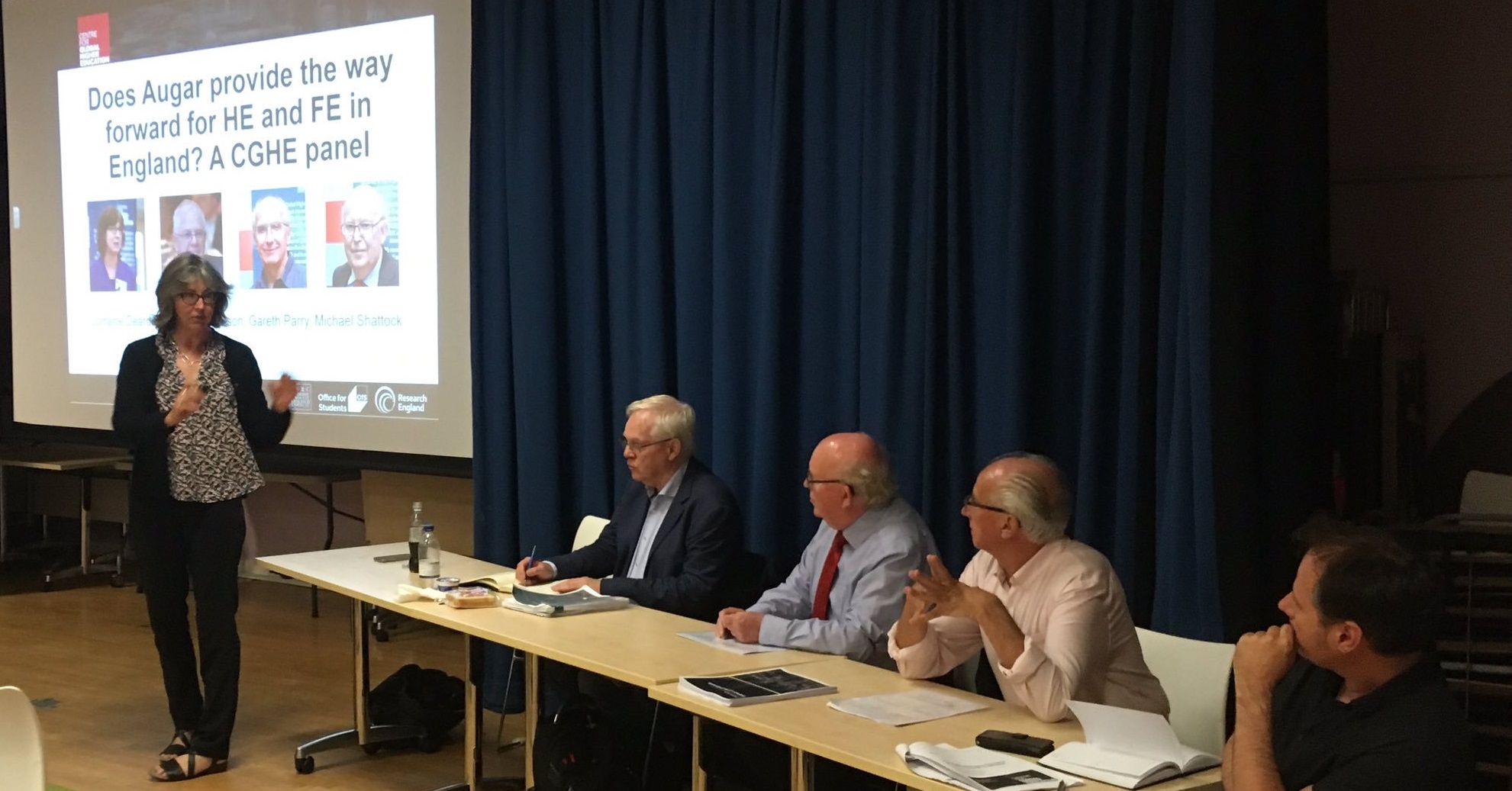CGHE panel unpacks landmark Augar Report
A crammed UCL Institute of Education drama studio last week heard from a special CGHE panel to analyse the strengths and weaknesses of the recent Augar Report.

The report, a long-awaited review into post-18 education and funding, was released at the end of May and has reignited debates across higher and further education.
The CGHE panel was held to discuss how Augar fits into the future of higher education and further education across the country, including relations between them, and the systems of tuition and student support.
Four members of the CGHE research team – Lorraine Dearden, Simon Marginson, Gareth Parry and Michael Shattock – discussed the cost of Augar, its impact on governance, its influence on different academic fields and the further education sector.
Distributional impacts
Each panellist gave an opening presentation, starting with Lorraine Dearden on the distributional impacts of the Augar proposals.
“My view is that I broadly support the recommendations of Augar,” said Dearden. “It is a move in the right direction. One of the best aspects in the report is the proposal to move to support all post-18 education.”
Dearden continued that the proposed re-introduction of grants is also sensible and involves small long-run costs but should improve access to post-18 education.
“The main winners of the Augar report are graduates in top 30% of lifetime earnings distribution,” she said. “However, it is not clear to me that’s an optimal way to do it.”
Dearden concluded there are still question marks over how teaching grants are going to be determined and there is not enough detail to fully understand the implications of rebalancing between fees and teaching grants. There is the danger that the Treasury won’t support the government funding needed to fill the gap between fees and costs.
Dignity for non-university options
CGHE director Simon Marginson spoke next. “There are a lot of good things about the Augar report,” he said. “It reasserts the role of planning and government, particularly in relation to FE and adult education. You might say it is post-neoliberal report and you would hope this approach to policy making will grow.”
“The report gives dignity to non-university options and brings them forward to create a scaffolding of participation, funding and public support which is comprehensive across the post-school age group,” said Marginson.
But the Augar panel was trapped in a zero-sum logic, said Marginson. It believed that FE could be expanded and upgraded only at the expense of HE. This led to spurious and destructive claims about “too many graduates” and “low value courses”.
Marginson produced a graph showing that the UK is halfway down to OECD table in the proportion of the population that become graduates. Graduate salaries are not the only indicators of value. Employment rates for social science, arts and humanities graduates are as strong as for STEM graduates though STEM graduates are paid more. And students choose courses not just for earnings but because they are intrinsically satisfying and help them to grow and develop as people.
A “timid” report
Michael Shattock offered a more disparaging view of Augar as he analysed the report from a governance perspective.
“I’m a little bit less enthusiastic about Augar than some of my colleagues,” said Shattock.
“I think it’s a timid report … Augar was a political reaction to the Labour Party’s indication that they were going to lower fees, if not do away with fees altogether. So this [Augar] was the government’s reaction to that and concerns about students carrying enormous debts,” he said.
Shattock said that if Augar had been undertaking a “bold report” then fees would have been reduced to around £4,500 and raised the contribution from the state to the same amount to create a shared operation.
“The report also does not mention any further arrangements,” added Shattock. “Augar was not concerned about looking at the long-term for HE at all.”
The FE view
Finally, Gareth Parry offered a perspective on further education and its prominence in Augar.
“Further education features strongly throughout the report, but it is intertwined with many other aspects. My pitch is that the report is mainly about one aspect: changing the shape of English tertiary education,” said Parry.
Parry outlined the post-16 template of education between the ‘academic’ route of A-Levels and university, and the ‘technical’ path of apprenticeships.
“What you are not seeing in Augar is any concept of an overarching tertiary authority over and above what is still a structure of national organisations, so we have the same assumptive architecture driving a differently shaped tertiary system,” added Parry.
The panel ended with an extensive Q&A session with the audience, where questions on funding issues in higher education, the effects of the Sainsbury Review, the impact of a foundation year and the role of maintenance grants were fielded by the panel.
